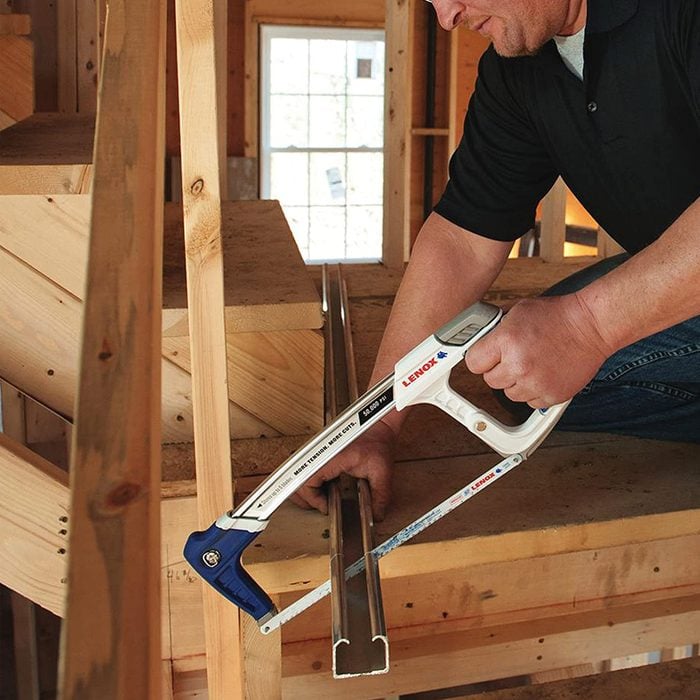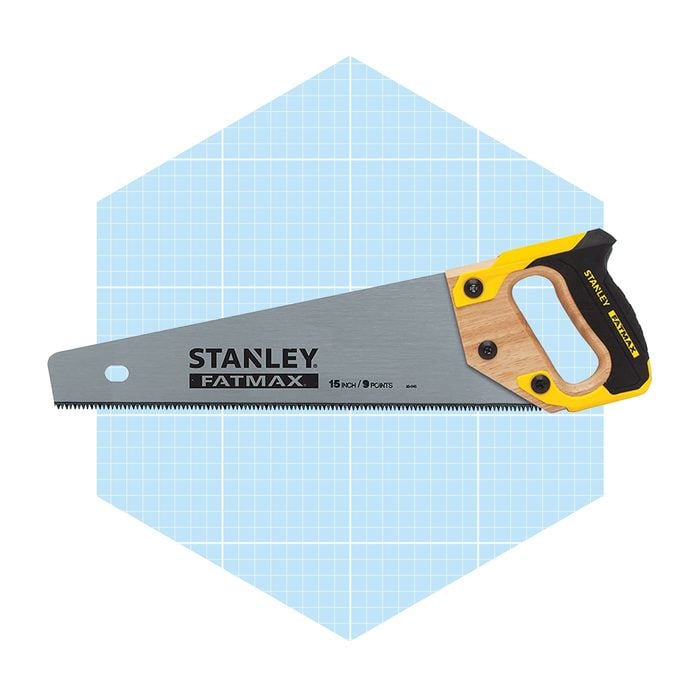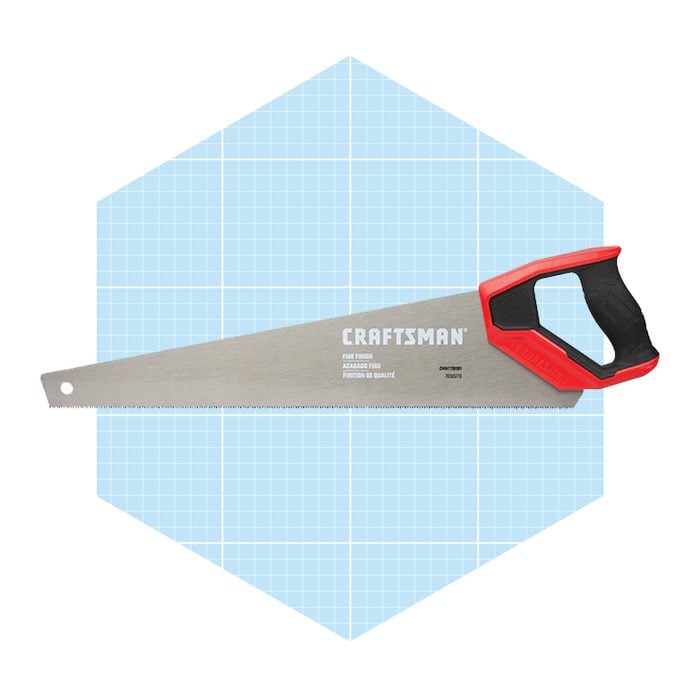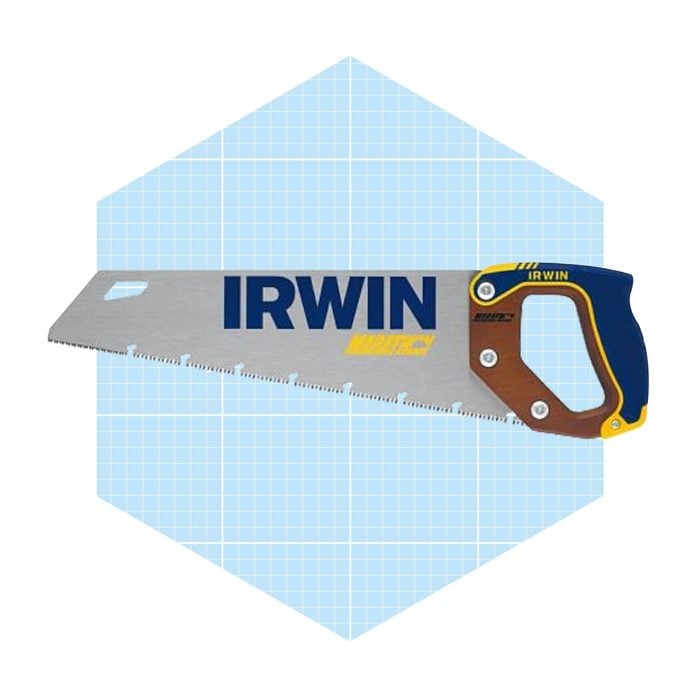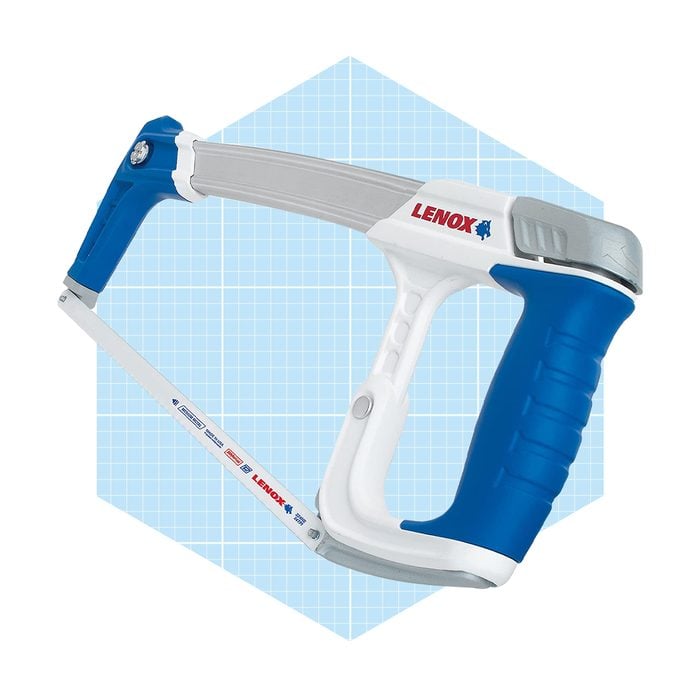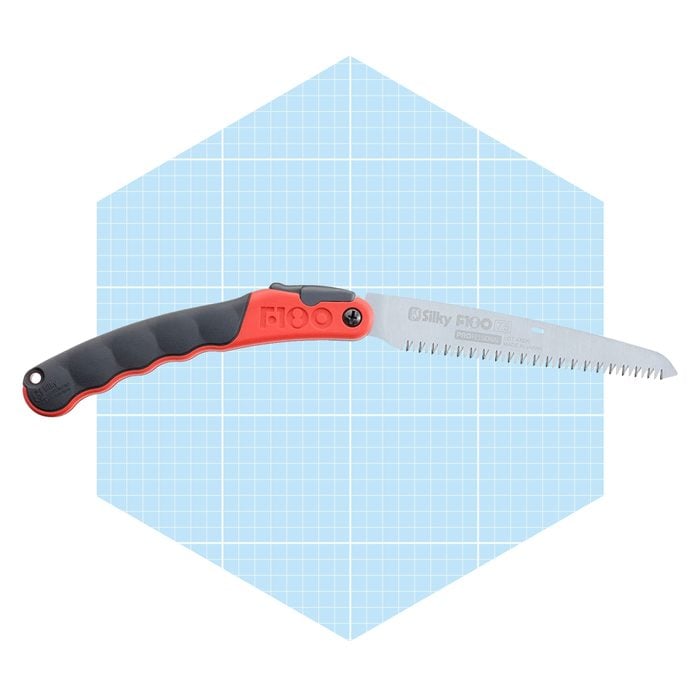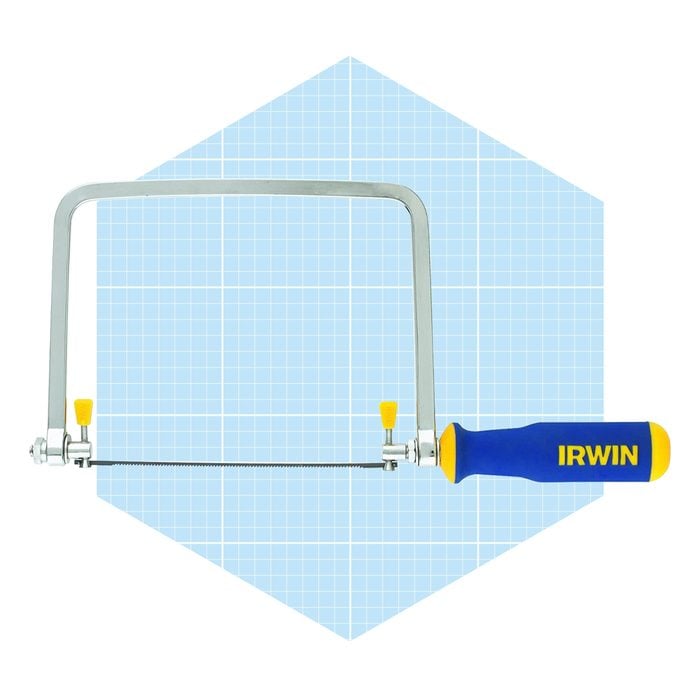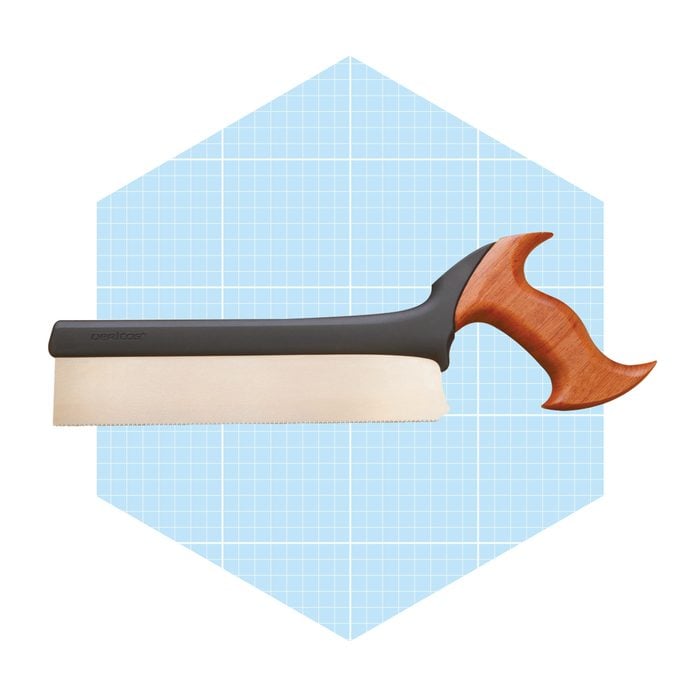Best Overall Handsaw
If I could only keep one handsaw in my shop, it would be the Stanley Fat Max. I’ve owned a Stanley Fat Max for more than a decade and I love it.
Most often, I use the 15-inch blade to rough cut hardwoods before joining and planning cabinet parts. I always have it with me for adding blocking on framing or drywall jobs, and I drag it to the bonfire for cutting up branches and logs. I’ve even cut piles of plastic and PVC with it.
To this day, its induction-hardened teeth (which I have never sharpened) are still strong enough to get through boards quickly without much effort. The Stanley Fat Max is all the best in one place — inexpensive, sharp, comfortable to use and well constructed.
Type: Panel saw.
Best for: Wood, wood products, plastics.
Blade length: 15 inches.
Teeth per inch (tpi): Nine.
Pros
- Affordable;
- Well-made;
- Comfortable handle;
- Versatile;
- Maintains its sharpness.
Cons
- Play develops over time in handle’s rivets.
Best Budget Handsaw
If you’re a DIYer who needs a handsaw for a weekend project, the Craftsman 20-in. Fine Finish Handsaw should be the one.
The sharp blade effortlessly plows its way through nearly any wood, plywood, laminate and plastic. The Craftsman 20-in. Fine Finish Handsaw features a long and sturdy blade that reminds me of the ones I used as a kid. The sturdy molded grip makes cutting 10 or 100 boards easy and comfortable.
The real hero of this story is the price. Because it costs less than a garden-variety t-shirt, you wouldn’t want to be without one for a “just in case” situation. Let your 13-year-old borrow this saw to build a school project so they don’t ruin a more prized one.
Type: Panel saw.
Best for: Wood, wood products, plastics.
Blade length: 20 inches
Teeth per inch: 11.
Pros
- Affordable;
- Long blade cuts quickly;
- Versatile.
Cons
- Doesn’t track well;
- Longer blade is more prone to binding.
Best For Coarse Cuts
The Irwin ProTouch Coarse Cut Saw is ideal for rough cutting boards, 2x4s, and limbs.
The stainless steel blade, with Irwin’s patented M2 tooth technology, features extra-fine teeth on its tip to initiate the cuts, and aggressive razor-sharp teeth to get you through the workpiece. The blade also incorporates deep gullets to provide rapid removal of sawdust and chips for fast, smooth cuts.
The Irwin 15-inch ProTouch Coarse Cut Saw is a beast, meant to saw quickly and efficiently.
Type: Coarse cut.
Best for: Wood and wood products.
Blade length: 15 inches.
Teeth per inch: 12 on the tip, nine along blade.
Pros
- Sturdy high quality blade;
- Fine teeth at tip for starting cuts;
- Comfortable handle.
Cons
- Hard to sharpen due to different tooth sizes;
- Handle inline with heel of blade is awkward.
Best For Metals
The Lenox HT50 High-Tension Hacksaw features a sturdy I-beam frame that allows for blade tensions up to a whopping 50,000 pounds per square inch, delivering fast, straight cuts. HT50 Hacksaws work with standard 12-inch blades and offer a hidden storage compartment for extras.
With the Lenox HT50 Hacksaw, you can cut through nearly any metal object. It also comes with a reciprocating saw blade holder that can turn the front end into a jab saw when in a pinch.
This hacksaw is exceptional. It’s suitable for lightweight cuts on gutters, bicycle handlebars or thick iron drainage pipes, and tracking well through all. As for the usual headache of switching out blades, Lenox made that foolproof, too.
Type: Hacksaw.
Best for: Metals and plastics.
Blade length: 12 inches.
Teeth Per Inch: 24.
Pros
- Precise cuts;
- Easily converts to a jab saw;
- Onboard blade storage.
Cons
- An expensive hacksaw
- Jab saw awkward to use.
Best For The Outdoors
Whether you want to prune or trim your yard or go camping in the backcountry, the Silky F180 is the handsaw you need. The seven-inch-long high-carbon Japanese steel blade offers 6.5 impulse-hardened teeth per inch that can last three times as long as non-hardened teeth.
The blade folds inside the lightweight fiberglass handle for safe storage in your pocket, toolbox or backpack.
Type: Pruning.
Best for: Limbs and branches.
Blade length: Seven inches.
Teeth per inch: 6.77.
Pros
- Sturdy high-quality blade;
- Folds for safety;
- Compact;
- Lifetime warranty against defects in material and workmanship.
Cons
- Short blade makes cuts take longer.
Best Pull Saw
The Shark Corp. Shark Saw Two-Sided Pull Saw is the handsaw I’ve used the most in the last decade. Due to their thin blades and three-edged diamond teeth, pull saws cut quickly and safely with minimal damage to the guiding object. Moreover, because they only cut on the pull, they track well and initiate cuts easily.
Mostly, I use the fine cutting side of the blade for cabinetmaking and trim work purposes — flush cutting dowels and plugs, squaring routed corners and undercutting casings. The more aggressive side is great for quickly rough cutting boards or sectioning bowl blanks from dried logs.
This is one of my favorite tools. I’ve used it almost everywhere. It’s razor sharp, and if you ever destroy a blade by cutting something you shouldn’t (as I have done many times), you can easily purchase a replacement blade from Amazon. I’m on my fourth!
Type: Pull saw.
Best for: Cutting wood.
Blade length: 9-1/2-inches.
Teeth per inch: 17 (aggressive side) and nine (fine side).
Pros
- Versatile;
- Flexible razor-sharp blade;
- Comfortable and lightweight;
- Multiple tooth patterns.
Cons
- Somewhat delicate blades.
Best For Coping Trim
If you’re planning to tackle a large trim or crown molding project a quality coping saw is a must. It’s used to back cut a molding’s profile at the end of the piece so it’ll fit over its adjacent piece of molding.
Coping saws aren’t the most versatile, so you don’t need to go overboard. Choose one with a deep enough throat to handle large pieces of trim. Also look for one that’s affordable and comfortable to use, and easy to control when cutting.
The Irwin ProTouch Coping Saw meets all those requirements. It features a standard 6.5-inch-long blade and a 5.5-inch-deep throat. The durable steel frame and pins provide sturdy and reliable use no matter how large the trim job.
Type: Coping saw.
Best for: Trim work and moldings.
Blade length: 6.5-inches.
Teeth per inch: 24.
Pros
- Inexpensive;
- Sturdy.
Cons
- Not versatile.
Best For Fine Woodworking
If hand-cutting joinery like dovetails or finger joints appeals to you, a dovetail saw is a must. Similar to back saws, dovetail saws have a thick reinforced spine to provide ultimate tracking and stability for tight and intricate joints.
The Veritas Dovetail Saw’s spine is made from an advanced material that incorporates stainless steel powder, glass fiber and a polymer resin. The incredibly solid one-piece assembly features a molded spine encapsulating the stainless steel blade and handle mount. And a single brass fastener to secure the hardwood handle.
The 9.25-inch, high-carbon steel blade comes with two tooth options to accommodate a range of material thicknesses. This dovetail saw is a comfortable and precisely manufactured tool for the most accurate of woodworking cuts.
Type: Dovetail saw.
Best or: Precise cuts, joinery.
Blade length: 9.25-inches.
Teeth per inch: 14 or 20.
Pros
- Comfortable;
- Sturdy construction;
- Tracks beautifully.
Cons
- Expensive;
- Polymer resin spin is harder to see around than traditional dovetail saw spines.
Types of Handsaws
There are dozens of types of handsaws out there. Panel saws, crosscut saws, hacksaws, back saws, jab saws, pull saws, keyhole saws, pruning saws and dovetail saws are just a few.
Handsaws come in three main categories:
- Panel saws: Also known simply as a handsaw, these consist of a flexible metal blade attached to a handle. Pull and crosscut saws are examples of this. A carpenter in the early 1900s would use a panel saw.
- Back saws: Similar to panel saws, these have one distinct characteristic — the back of the blade or spine is reinforced to keep it rigid and produce straight, precise cuts. Dovetail and traditional miter box saws are examples of back saws.
- Frame saws: These feature a sturdy frame, usually metal, which applies tension to a blade to keep it rigid and straight cutting. because frame saws can exert excessive amounts of tension on their thin blades to keep them from binding, they are most often used to cut heavy materials like metal, or make curved cuts. Examples of frame saws are hacksaws, coping and bow saws.
What To Consider When Choosing a Handsaw
Start by identifying the material you’ll be cutting (wood, metal, plastic, moldings, etc) and the type of cut you’ll make (curved, straight, fine, coarse).
The teeth per inch (TPI) is another significant factor to consider. The higher the TPI, the more fine the cut will be. For portability and cutting speed, blade length is also a consideration. And always keep your budget in mind.
